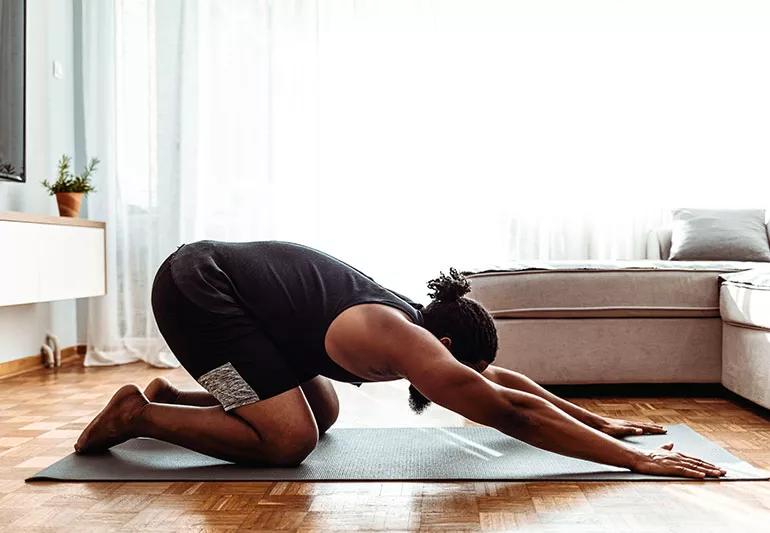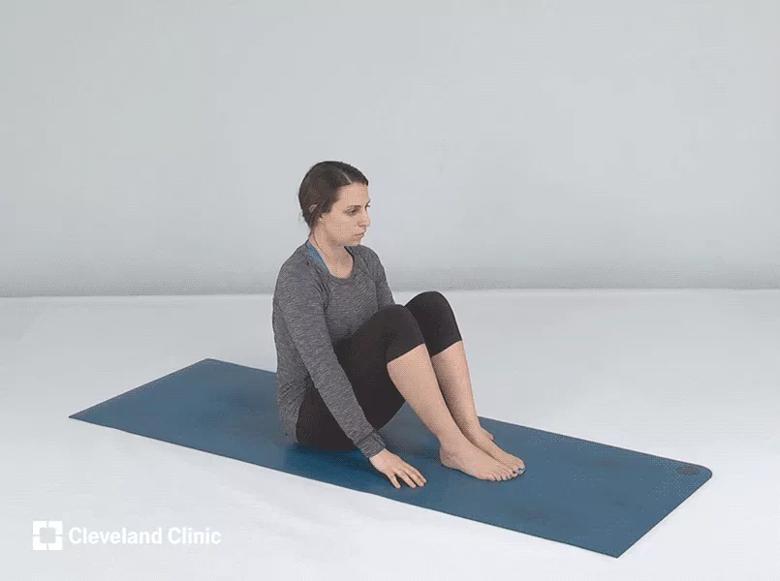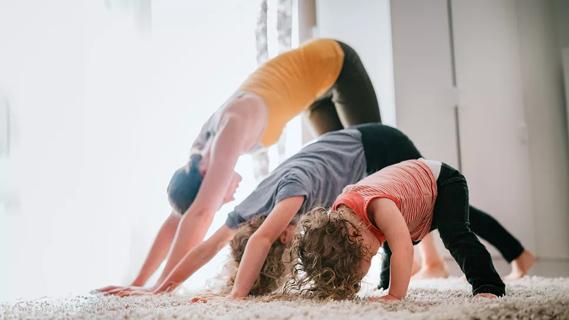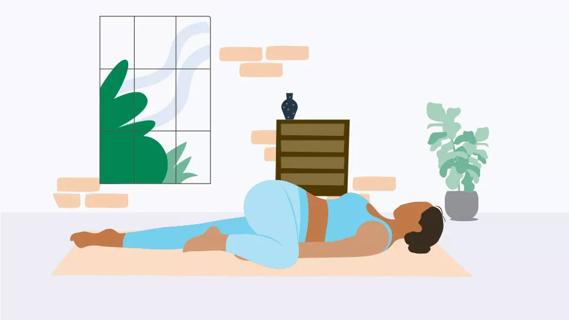Regular yoga practice can improve your flexibility and increase — or regain — your range of motion

Flexibility isn’t just about doing the splits or touching your knee to your nose (but congratulations to you if you can!). Keeping your body flexible is important throughout your day-to-day life.
Advertisement
Cleveland Clinic is a non-profit academic medical center. Advertising on our site helps support our mission. We do not endorse non-Cleveland Clinic products or services. Policy
Turning your head side to look out your passenger side window requires flexibility. So does bending over to put on your socks and tie your shoes. Or reaching up to get a jar from a high shelf.
“Reduced flexibility can really impact function, even when you think about standing up from a chair or getting up off the floor,” says Johanna Goldfarb, MD, a yoga instructor and retired pediatrician. “When your body becomes less flexible, you can end up with deformities, and with pain. These symptoms can increase with age and become harder to reverse.”
We talked with Dr. Goldfarb about how yoga can work to maintain flexibility and some poses you can use to increase your range of motion.
When it comes to flexibility, your body has a kind of “use it or lose it” rule. Muscles that don’t see enough regular work can become rigidly fixed in position — robbing you of your body’s full range of motion and limiting your capabilities.
Stretching your body regularly can lengthen your muscles and help you maintain flexibility in your joints. The good news is, that stretches can also help restore some flexibility to muscles that have lost some of their elasticity.
“If you have some tightness when you’re young and you don’t take steps to address that, chances are it’s going to be harder to reverse as we age. Not impossible, but harder. Especially when conditions like arthritis and osteoporosis start to set in and further limit your abilities,” Dr. Goldfarb says.
Advertisement
It isn’t necessary to use advanced yoga poses. Simple movements can have a large effect. Dr. Goldfarb walks us through some of her favorite poses to increase flexibility throughout your body.
The simple act of sitting or standing with good posture may be the most important first step in addressing flexibility in our bodies.
Start by sitting or standing with a straight — but not rigid — back. Push the small of your back to straighten and then release it to a normal curve. Engage your core muscles (your abdominal and back muscles) so your posture is tall, dignified.
Slow your breathing and begin to make your exhales as long as your inhales.
Just standing or sitting tall and breathing this way is the best way to begin a practice to stretch muscles. By triggering a relaxation response, your muscles will become more responsive to your movement, Dr. Goldfarb notes.
We carry a lot of stress in our necks, which often translates into holding them stiffly and perhaps leaning forward.
Again, sit up tall, and engage your core muscles.
After a long, slow inhale, exhale and begin to make circles with your neck by pointing your nose to an imaginary clock face. Start at the 12 o’clock position and move your nose slowly around the clock, rotating your head.
After three slow circles around the clock, come to the 12 o’clock and stop.
Inhale. On your next exhale begin to move in the opposite direction. Remember to only move into spaces that give your muscles a gentle stretch, never pain.
Inhale and gently tilt your head towards the ear on that side, keeping your posture and shoulders level. Hold for a breath. You should feel a stretch on the opposite side of your neck.
On an exhale, bring the opposite ear to the opposite shoulder. Only go as far as feels good in your body, and remember to breathe.
Inhale. On an exhale, turn to look over one shoulder. Keep your chin level and go only until you feel a gentle stretch in your neck muscles. Breathe, and hold for one to three breaths.
Inhale. On your next exhale turn to look over your opposite shoulder. Breathe, and hold for one to three breaths.
Sit up tall, and engage your core. On an exhale, tilt your head forward looking down. Go only until you feel a gentle stretch. Stop and breathe for one to three breaths.
On an exhale, slowly and gently take your gaze up as you stretch your neck in the opposite direction. Go only as far as to see where the ceiling meets the wall — less if you begin to feel the stretch sooner. Remember, you’ll increase your flexibility through consistent, gentle practice, not by force.
Advertisement
We carry much of our stress in our shoulder joints and muscles, Dr. Goldfarb says.
Begin by sitting up tall, engaging your core and breathing slowly.
On an exhale, slowly lift your shoulders towards your ears and begin to make shoulder circles, moving from front to back. Aim for about five circles.
Take your arms behind your back and gently reach back. Keep your back straight at first and then perhaps bring your chest forward gently if that feels good. Breathe with the movement, and stop when you get to a place where you feel a stretch in your upper shoulders.
It’s easy to take for granted the number of things that your wrists do for you each day. Like lifting, gripping and pulling.
Keeping your fingers relaxed (neither straight nor clenched in fists), gently roll your wrists in circles. Go clockwise a few turns, then counter-clockwise. You can also move your wrists as if you were drawing the alphabet to change it up. Open and close your fingers.
Having a mobile back is key to being able to perform many activities of daily living, including emptying the dishwasher, sitting, standing and picking up things from the floor — to name a few. When we stay in prolonged positions throughout our day, we can cause the muscles in our lower back to tighten up, Dr. Goldfarb explains.
Advertisement
Begin by sitting or standing with a straight — but not rigid — back. Push the small of your back to straighten it by engaging your abdominal muscles and then release letting it come to a normal curve.
Take your arms forward with straight elbows at shoulder height. At the same time, look down at your lap. Come to “cat” pose, allowing your upper back to round (like a cat stretching). Take several breaths here.
Then, on an exhale, bring your arms back and lift your head, looking up comfortably and curve your spine gently in the opposite direction. (This is called “cow”).
If this is comfortable for your back, you can move with your breath, going from cat to cow and back. Move only as you start to either inhale or exhale.

Begin by lying on your back with your knees bent. Engage your lower back and tilt it back and release. Engage your core muscles.
Breathe in slowly. On your exhale, bend one knee and straighten the other leg on the floor or mat. Gently draw your knee into your chest with the opposite hand. Keep the opposite leg outstretched.
Lower the bent leg across your body to the opposite side, and extend the same-side arm in the other direction. Turn your head in the direction of your outstretched arm. Only go until you feel a gentle stretch. Switch and do the other side.
Advertisement
You can place a block or pillow under your bent knee for added comfort.
Tight hips are very common, especially among people whose jobs are mostly desk-bound. There is a range of yoga poses for the hips, with varying degrees of intensity.
While sitting on the floor or a chair, sit up tall, engage your core muscles and breathe. On an exhale, straighten one leg, bend the knee of the opposite leg and slowly walk that foot up your straight leg until you feel a stretch in your hip. Stop when you feel that stretch. Don’t rest your foot on your knee.
If you aren’t feeling a stretch yet, bend the supporting knee to 90 degrees and bring the opposite leg across to rest on the thigh of the supporting leg. If you still need more, sit up with a straight back and bend from your waist to increase the stretch.
Limber hamstrings are crucial to getting about your day. “You need strength and flexibility in your legs to walk, or to squat or just move through daily life,” Dr. Goldfarb states. “If you don’t use your hamstrings and they become stiff, you can have trouble bending your knees and just getting around.”
Sit up tall with both legs stretched straight out in front of you. Try to inch the backs of your knees to the floor. The goal is for your legs to be totally straight, but not hyperextended.
Keep your toes flexed and your upper body lifted. Hold for a few breaths. Some people may find sitting on a rolled-up towel or yoga block is easier than sitting on the floor. Or sit with your back against a wall if that’s more comfortable.
If you need more of a stretch, you can lean forward with a straight back. Engage your core, coming only as far forward as you can with a straight back and only until you feel a gentle stretch. Breathe.
Sit up back into seated mountain pose. You can use a strap here around the foot to help keep your back straight as you stretch the muscles of your leg.
While standing, spread your legs to just about shoulder-width apart. Turn your front foot 90 degrees forward and your back foot to about 45 degrees off center.
With straight knees, straighten your back and engage your core.
Breathe in. On an exhale, slowly bend at your waist toward your front foot, keeping your back straight and only going until you feel a stretch in your leg muscles. Place your hands on your front leg to support the pose (or lower if you can do so with a straight back).
Keep your back flat, and don’t go any farther than you can go with a straight back. Breathe. Return to standing mountain pose and reverse your legs.
Keeping your feet flexible will help you keep your walking balanced as you age.
Dr. Goldfarb points out, “When we practice yoga, we usually do it barefoot, so that at all points during your practice, your feet are getting some stretching.”
Sitting on the floor or in a chair, scrunch your toes down toward the floor. Hold for a breath. Then flex them up to the ceiling. Hold for a breath. Add some ankle circles, moving your foot around in a circle, both legs, both directions. You may not get much movement in your toes, and that’s normal.
While sitting on a chair or standing, lift your ankles so your heels come up off the floor (you can use a wall or chair for balance if you’re standing). Hold for a breath and lower back to the floor.
A good yoga instructor will suggest modifications to poses to meet your body’s abilities. In just about every yoga pose, there are ways to enhance or pull back on a pose to work for your body. Sometimes, this could mean using a chair, a strap or other yoga props.
“I often recommend starting with a chair yoga class and seeing what your strength is and then graduating down to the mat,” Dr. Goldfarb says. “Remember that if an instructor is doing a pose you can’t get to, you can always sit it out. Go in knowing that you may not do everything that happens in a class, and that’s OK.”
Dr. Goldfarb reminds us to keep your yoga practice gentle, especially as you first get started. Poses should be entered into and moved out of slowly to protect your muscles and joints.
If you have any baseline injuries or pain, consult a healthcare provider before starting a yoga practice.
Learn more about our editorial process.
Advertisement

This gentle yoga stretch supports your spine, strengthens your core and calms your mind

Focus on inhaling and exhaling through 12 steps of a complete sequence

Stand tall and feel grounded with this foundational yoga pose

This transitional and restorative yoga pose provides a full-body stretch

Somatic yoga focuses on the sensation and experience of movement — not striking perfect poses

Balasana, or child’s pose, is a restorative full-body yoga technique

Kids’ yoga can help kiddos become more aware of their physical, mental and emotional selves

This mindful practice is designed to give you mental and physical relaxation

The best parenting style balances enforcing rules and showing plenty of love

Tips include cutting back on sugar, focusing on exercise and managing stress

It can be harder to let go when you’ve invested time, energy and emotions — but it might be the healthier choice long term